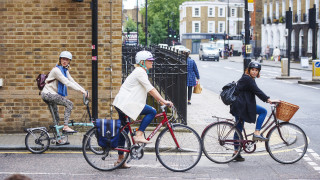In the first of a five part series looking at the Cycling and Walking Investment Strategy consultation, Martin Key, British Cycling campaigns manager, explores the government’s ambition "to make cycling and walking the natural choice for shorter journeys or as part of a longer journey".
We believe that for cycling to be the ‘natural choice’, this means that choosing to cycle is the default choice for all ‘cyclable’ trips. Transport for London suggested that at least 23% of all journeys in London were ‘cyclable’, so the potential for growth from current levels is huge and we should be far more ambitious with our approach.
The strategy is a huge opportunity to set the country on a course to transform levels of cycling and walking by 2040, and the ambition is welcome.
2040 is a long way off but so is the ambition. 69% of journeys under five miles are taken by car, 22% of journeys are walked and less than 2% are cycled.
If the ambition is to be achieved, to make walking and cycling the ‘natural choice’, the strategy must set out a clear pathway with milestones along the way. This is currently missing from the document. The legislation which enshrines the strategy states that the government must report to parliament at least every five years so there is a political requirement to get it right, as well as an obligation to all road users.
The strategy divides the delivery of the government’s ambition into three themes: ‘Better Safety’, ‘Better Mobility’, and ‘Better Streets’.
Better Safety
'Better Safety' should be fairly self-explanatory. It means improving the actual and perceived safety of cycling and walking which is the single biggest factor preventing people from cycling.
The fatality rate in the UK is three times higher than in the Netherlands. The problem is also getting worse. The rate of those killed and seriously injured is growing, with an increase of 8.2% from 2013 to 2014 with only a 3.8% increase in cycling traffic over the same period.
The Department for Transport’s Road Safety Statement is referred to as the driving mechanism for actions but it merely refers to the Cycling and Walking Investment Strategy, leading to a self-fulfilling circle of inaction.
The strategy details various short-term actions, including implementing new traffic signs (published on 22 April), £100m of funding for Highways England (announced in 2014) and continued funding for Bikeability (announced in 2015). All of these measures are live now but what of the future, the next five, ten and twenty years?
The Strategy needs to permanently link improvements in safety to the development of segregated infrastructure on main roads and traffic calming on residential roads. This is how the Dutch and the Danes achieve a much lower casualty rate than we do.
The roll out of this infrastructure will take many years but with an ambition to 2040 to reduce the rate of casualties the strategy should sketch out progress of how we get there. There needs to be actions to align road user behaviour, enforcement, vehicle standards so they complement the introduction of cycling infrastructure.
Better Mobility
‘Better Mobility’ is about making it easy to integrate cycling into daily life so it becomes seamlessly compatible with everyday journeys. The section contains the most pro-active actions including the development of guidance for Local Cycling and Walking Infrastructure Plans (LCWIP), a new Access Fund for Local Economic Partnerships and government-led investment in parking at railway stations.
It is the LCWIP which brings into focus the complete lack of direct funding available to kick-start the strategy. For enthusiastic local authorities, the LCWIP offers an opportunity to accelerate plans to develop modern cycling networks, bringing some of the same tools available in London and Wales to the rest of England. However with little funding available, it will be for local authorities, who are already hard-pressed, to reprioritise scarce resources. In the Netherlands, local authorities received up to 70% contribution for building cycle lanes from the 1970s, when national government started to prioritise cycling.
The Strategy also needs to model how it will meet the objectives to reverse the decline of walking and increase the proportion of children walking to school.
Better Streets
‘Better Streets’ is about creating well-designed places where cycling and walking seem like a natural option. Two projects stand out; a review of 20 mph speed limits and another on pavement parking. Local authorities are severely restricted in implementing cycle-friendly measures because each traffic order, be it 20mph, restricted access or reallocating parking spaces, must be completed individually making it expensive and time consuming. Anything which gives local authorities more powers would be a good thing.
The big action missing from this section is a commitment to implement national design standards for cycling infrastructure. Without it, public money will be wasted on schemes which do not meet the needs of people choosing to cycle or worse, may be dangerous. The government does not need to reinvent the wheel; the London Cycling Design Standards is recognised as best practice meaning it could simply endorse them.
The ambition ‘to make cycling and walking the natural choice for shorter journeys or as part of a longer journey’ is welcome but there needs to be tangible milestones along the way to achieve the government’s targets and ambition up 2040.
Over the next five weeks, we'll continue to take a look at the Cycling and Walking Investment Strategy. You can have your say on the strategy by responding to the consultation, which closes on Monday 23 May at 11.45pm.





